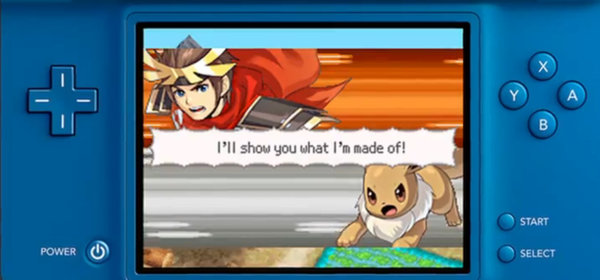Quick Search
Navigation
Featured Articles
- The Monsters of the Wailing Prison
- Strider Review
- BioShock Dev Irrational Fires All But 15 Employees
- New Titanfall Maps Confirmed
- There Are Aliens In Titanfall
- Guide: How to Dominate The Elder Scrolls Online PvP
- The Elder Scrolls Online PvP Experience
- Get Glow-in-the-Dark Condoms For Pre-Ordering InFamous: Second Son
- Batman: Arkham Origins Devs Have No Intention To Fix Bugs - Working On DLC Instead
- 8 Exclusive ESO Screenshots
Pokemon Conquest Review
- 6-25-2012
- Categorized in: Reviews, Video Game News

The Pokemon games were a highly influential staple of my childhood. I can still remember the excitement coursing through my little veins as I unwrapped a copy of Blue Version on my birthday. This game served not only as my gateway into new and challenging role-playing games, but video gaming altogether. Would I be half as passionate about gaming without Pokemon and the subsequent versions of the game? It's debateable.
Having said all that, it's been a bit depressing to watch the evolution of the Pokemon franchise as I made my way into adult life. The games kept coming, and to Nintendo's credit there was always just enough in the way of new content and connectivity features to make things feel slightly different. But at a certain point, "just enough" ceases to be enough, and fans demand a different experience. That, in a nutshell, is what Pokemon Conquest is. This is very much the same Pokemon that many of us grew up loving, but slipped neatly into the veil of an entirely new genre. The transition is shockingly smooth.
Pokemon Conquest brings the tried-and-true "Gotta catch 'em all!" conceit into the past while simultaneously ushering it towards the future. By visiting fuedal Japan (here called Ransei) as it existed in the Pokemon universe, Nintendo and developer Tecmo Koei have opened up all sorts of new and exciting avenues for the future of the franchise. As one may expect from a game set during a fictionalized version of Japan's tumultuous Warring States period, the core of the gameplay revolves heavily around establishing powerful armies to defend your kingdoms, all while branching out and attacking neighboring states.
This new focus necessitates a new style of gameplay, and the strategic warfare of the Nobunaga's Ambition series turns out to be the perfect fit. Combat now plays out on a grid, with each Pokemon being able to move and attack only a certain distance each turn. Some Pokemon can move farther than others, so expect Flying-types to go soaring far past cumbersome Ground-types. Each Pokemon also has its own unique attack style, which translates to unique areas of effect for each creature. For example, the Eevee that you will begin the game with can attack only the squares adjacent to him. The Charmander that you will soon receive, on the other hand, is more of a ranged character, and can shoot fiery Ember attacks at opponents from a distance. This gives each Pokemon its own unique feel during combat, and helps to make creating an army more strategic and flexible.
If there's a major downside to Pokemon Conquest, it's that each Pokemon only has one active skill. Charmander will only be able to use that Ember attack, and Eevee wil always only be able to attack the enemies that are right next to it. This makes the battle system less flexible than it could have been if each Pokemon were to have four moves, like they do in the RPGs. Passive skills serve to add a little bit of variety to the proceedings though, and this is appreciated. Jigglypuff comes equipped with the Lullabye ability, which can put the surrounding enemies to sleep if a certain set of conditions are met. Meeting the conditions of these passive skills does add a bit of unique strategy to the game, offsetting a little of the disappointment resulting from the overall lack of skills at your disposal in each battle. Finally, each Pokemon can be equipped with one item, so you will have to grapple with the decision of whether to bring a Potion or an Anti-Freeze item into battle. Overall, combat has enough depth to remain consistently entertaining, even though there's plenty of room for more nuance and control in future installations.
Just as in the RPGs, Pokemon become completely different when they evolve. Evolving Pokemon is done by hitting a certain percentage on the Loyalty meter, basically a simplified version of the levels from the RPGs. When a Pokemon changes forms, its attacks, stats, and movement capabilities often change along with it. Because of this, combat is constantly, ahem, evolving, and it makes the game feel incredibly dynamic as a result.

Doing battle is only one part of the Pokemon Conquest experience, though. In true Nobunaga's Ambition fashion, players will have to capture and hold enemy States by invading them with their armies. This coneit makes up the crux of the story, which is light and generally devoid of serious characterizations but snappy and fast-moving enough to drive the game forward for its 20-hour runtime. You and your ever-growing army will begin the game by waging a few battles for fun, but after you begin to capture more and more States it will become clear that you are the only hope of stopping the devious Nobunaga from capturing all of Ransei. You see, laying claim to all of the territories in Ransei is said to summon a legendary Pokemon to serve whosoever rules the land, and Nobunaga aims to use its power to conquer and destroy the world.
Each State is presided over by a ruler and his or her subjects, who will loyally fight you and your army for control of the land. You will thus have to challenge the ruler's Pokemon in battle in order to wrest control of the State for yourself. These battles are where you will spend the majority of your time in Pokemon Conquest. Each State has its own unique features like shops, rest stops for your Pokemon, and training grounds where you can find and bond with new creatures, but level grinding is, pleasently enough, never necessary. You can always stop in the training grounds to try out a new Pokemon or attempt to capture new allies, but the game never forces it upon you. This keeps everything moving along at a great clip, and places the emphasis solely on the battles that matter.
Preparing for those battles can be a bit of a hassle, though. Once you have taken control of most of Ransei, you will have to juggle tons of States, each of which is inhabited by different members of your army. You will typically go into battle with a force of six Pokemon, and as such each State can hold a maximum of six Pokemon in it at any given time. That said, each enemy State will have wildly differing types of Pokemon in it, and you will want to make sure that you have the correct elements present in your party to deal with the types and affinities that the enemies will be throwing at you. This can require a lot of moving Pokemon around from one State to another, swapping Pokemon between States that are already at full capacity just to get them all to the State that you actually care about. It would be nice if, when initiating battle, you could simply select which Pokemon you wanted to bring along from a menu instead of juggling all of them around on the overworld map beforehand.
Other elements of State management are much more smoothly handled. You can give basic orders to each of your States individually, but only if at least one Pokemon is present there. The most useful order is the Train command, which effectively eliminates the need to grind levels with Pokemon that you don't regularly use in battle. The Train command will automate battle while you and your party are off doing other things, leveling up Pokemon not in your active party just like a Day Care might in the RPGs.
Just as you take States from your enemies, so too might they come back to reclaim them from you. For this reason, it is always necessary to keep a strong force of Pokemon present in states that border enemy territories, lest you lose footing in the area and have to re-organize your troops to retake it. This Risk-lite give-and-take of territory complements the deeper core combat of the game nicely and makes for some truly harrowing battles later on in the campaign.
I mentioned earlier that the campaign runs at around 20 hours in length. While that might be longer than most games these days, it's also quite sparse for a game in the turn-based strategy genre, especially one bearing the Pokemon name. Luckily, there's much more gameplay to be found after the story has been conquered. New territories with challenging warlords and Legendary Pokemon await you in the eighty-plus hours of post-game content, and it's in these moments that the game truly shines. The combat will become more demanding, the overworld give-and-take more harrowing, and the capturing of Pokemon that much more satisfying. Don't get me wrong, the story is excellent, but it's what comes after that will truly thrill and challenge you.
All of this tactical action is rendered lovingly in the form of some incredibly detailed and charming sprites. Each Pokemon has its own combat animations, and each evolved form changes and immproves upon these animations nicely. The overworld map is similarly detailed, with the motif of each State shining through loud and clear even on the DS Lite's tiny screen. An Air-themed State will look entirely different than a Grass-themed state, and the rulers of each State will be embodied by some great character portraits. The sound design is similarly detailed. Although there are no voiceovers for the story, each Pokemon will be accompanied by their own unique call pulled straight from the Pokedex of the RPGs.
Pokemon Conquest strikes out into uncharted territory using the Pokemon that we all know and love as the jumping off point. The result is an incredibly successful melding of excellent turn-based strategic action and the "Gotta catch 'em all" mentality of the RPGs. Battles could be a little more flexible, but other than this relatively mild complaint it's hard to find fault with Pokemon's first forray into the exciting and flexible world of Ransei.
Score: 9/10




